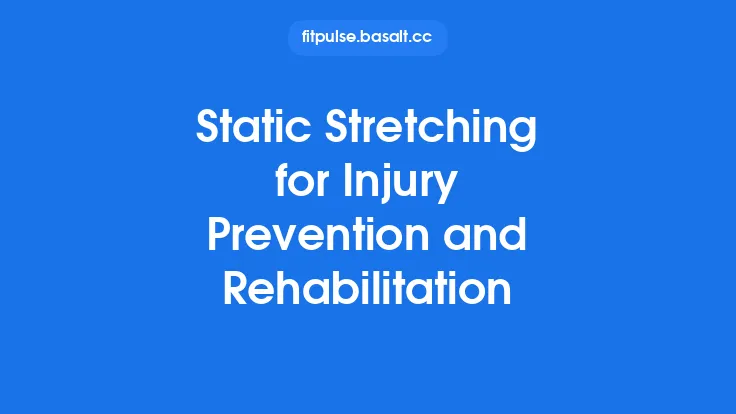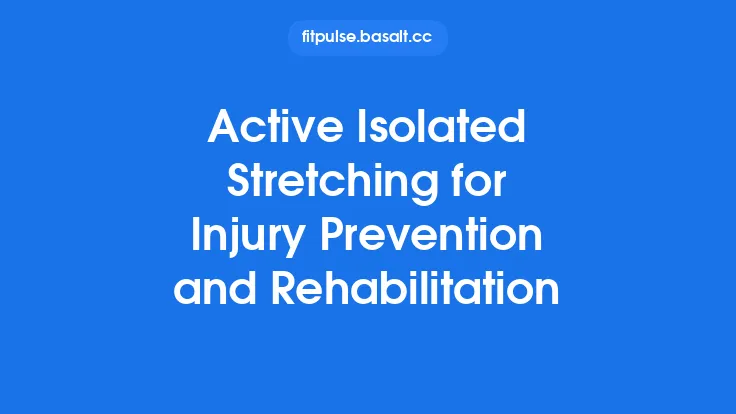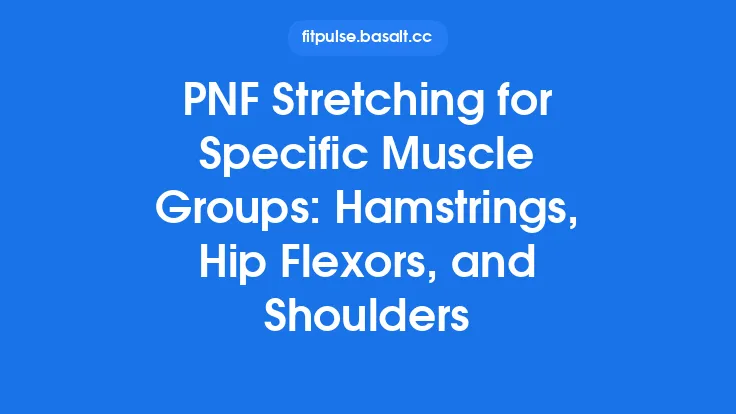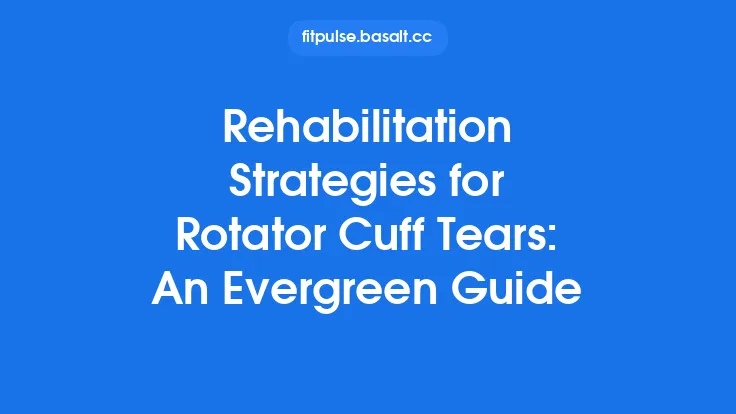Restoring mobility after an injury is often a complex puzzle that requires more than just passive rest or generic stretching. Proprioceptive Neuromuscular Facilitation (PNF) offers a uniquely interactive approach, leveraging the nervous system’s capacity to “re‑teach” muscles how to move safely and efficiently. When applied thoughtfully within a rehabilitation framework, PNF can accelerate the return of functional range of motion, improve joint stability, and help prevent the recurrence of injury. Below is a comprehensive guide for clinicians, therapists, and informed patients on how to integrate PNF stretching into a rehabilitation program, from initial assessment through progressive re‑integration into daily activities.
Understanding the Role of PNF in Rehabilitation
PNF is more than a stretching technique; it is a neuromuscular facilitation strategy that exploits the body’s reflex pathways to enhance both flexibility and motor control. In a rehabilitation setting, the primary objectives differ from those of a purely performance‑oriented program:
- Neuromuscular Re‑education – Injured tissues often lose the ability to coordinate properly. PNF stimulates proprioceptive receptors (muscle spindles, Golgi tendon organs, joint capsule afferents) to restore accurate feedback loops.
- Controlled Lengthening Under Load – By pairing a gentle contraction with a subsequent stretch, the muscle is taught to tolerate tension at longer lengths without triggering protective guarding.
- Reciprocal Inhibition for Joint Protection – Engaging the antagonist muscle during a stretch can reduce excessive co‑contraction, which is common after trauma and can impede healing.
- Facilitating Tissue Remodeling – The cyclic loading and unloading inherent in PNF can promote collagen alignment and improve the viscoelastic properties of scar tissue when applied within safe limits.
These mechanisms make PNF especially valuable for injuries where both range of motion and neuromuscular control are compromised, such as post‑operative joint repairs, muscle strains, ligament sprains, and post‑fracture immobilization.
Assessing Injury and Determining Suitability
Before any PNF intervention, a thorough clinical assessment is essential. The following steps help determine whether PNF is appropriate and how it should be tailored:
| Assessment Component | Key Considerations | PNF Implication |
|---|---|---|
| Stage of Healing | Acute inflammation vs. sub‑acute vs. chronic | Early stages may only tolerate low‑intensity isometric activation; later stages can incorporate more dynamic PNF patterns. |
| Pain Threshold | Presence of nociceptive pain, mechanical pain, or referred pain | Pain that increases with stretch suggests the need for a gentler facilitation or alternative modalities first. |
| Joint Stability | Ligamentous laxity, joint capsule integrity, presence of effusion | Unstable joints may require bracing or controlled isometric activation before applying stretch. |
| Neuromuscular Control | Ability to voluntarily activate agonist/antagonist, presence of guarding | PNF can be used to break down guarding, but initial focus may be on isolated activation without stretch. |
| Functional Goals | Return to gait, sport-specific movement, ADLs | Determines which movement patterns (e.g., hip extension, shoulder abduction) will be prioritized in the PNF protocol. |
A decision matrix can be created to map the injury characteristics to a PNF “intensity tier” (low, moderate, high). For example, a Grade II hamstring strain in the sub‑acute phase may be placed in the moderate tier, allowing for low‑load isometric contractions followed by a gentle stretch, whereas a post‑rotator cuff repair in the early healing phase would remain in the low tier, focusing on isolated activation without stretch.
Designing a Rehabilitation‑Focused PNF Protocol
A PNF protocol for rehabilitation should be built around three core phases: Activation, Facilitation, and Integration. Each phase has distinct objectives and progression criteria.
1. Activation Phase (Weeks 0‑2)
- Goal: Re‑establish baseline neuromuscular firing patterns without imposing excessive stretch.
- Technique: Low‑intensity isometric contractions (10‑20% maximal voluntary contraction) held for 3–5 seconds, repeated 3–5 times per muscle group.
- Example: For a knee flexor strain, the patient lies supine, gently contracts the hamstrings while the therapist provides light resistance at the distal tibia. No joint movement is allowed; the focus is on feeling the muscle engage.
2. Facilitation Phase (Weeks 2‑6)
- Goal: Introduce controlled lengthening while maintaining neuromuscular activation.
- Technique: Combine a brief, sub‑maximal contraction (15‑30% MVC) with a passive stretch that respects the patient’s pain tolerance. The stretch is held for 6–10 seconds, then released.
- Progression Variables:
- Load: Increase contraction intensity by 5% increments as tolerated.
- Duration: Extend stretch hold by 2‑3 seconds each session, up to 15 seconds.
- Range: Gradually increase joint angle by 5°–10° per week, guided by pain and tissue response.
- Example: For a post‑operative shoulder, the patient performs a gentle isometric external rotation against a therapist’s hand, then the therapist assists the arm into a safe, pain‑free adduction stretch, holding briefly before returning to neutral.
3. Integration Phase (Weeks 6‑12+)
- Goal: Translate the newly acquired flexibility and motor control into functional movement patterns.
- Technique: Incorporate PNF within dynamic, task‑specific drills (e.g., gait training, squat to stand, overhead reaching). The stretch‑contract cycle may be embedded within the movement itself, such as a controlled “step‑back” lunge that includes a brief hamstring contraction before the forward step.
- Criteria for Advancement:
- Pain ≤ 2/10 on a visual analog scale during the stretch.
- Ability to achieve ≥ 80% of the pre‑injury range of motion.
- Demonstrated control of the joint through functional tasks without compensatory patterns.
Progression Strategies and Monitoring
Effective rehabilitation hinges on systematic progression and objective monitoring. While the article “Measuring Progress in PNF Stretching” is off‑limits, the following pragmatic tools can be employed without duplicating that content:
- Range‑of‑Motion Checkpoints – Use a goniometer or inclinometer at the start of each session to record the active and passive angles achieved. Document the change relative to the previous session.
- Pain and Perceived Exertion Logs – Have the patient rate pain (0‑10) and perceived effort (Borg scale) after each set. A decreasing trend indicates adaptation.
- Functional Milestones – Define task‑specific goals (e.g., “walk 20 meters without limp,” “lift a 5‑kg object overhead”) and assess performance weekly.
- Neuromuscular Activation Quality – Employ surface electromyography (sEMG) or manual muscle testing to verify that the targeted muscle is firing appropriately during the contraction phase.
- Tissue Response Observation – Look for signs of excessive swelling, bruising, or increased joint laxity, which would signal the need to regress the protocol.
Progression should be individualized; a patient who demonstrates rapid neuromuscular recovery may move to the Integration Phase earlier, while another with lingering inflammation may require an extended Facilitation Phase.
Integrating PNF with Complementary Therapies
PNF does not exist in isolation. For optimal rehabilitation outcomes, it can be synergistically combined with other evidence‑based modalities:
- Manual Therapy – Soft‑tissue mobilization or joint mobilizations performed before PNF can reduce tissue stiffness, allowing a more effective stretch.
- Therapeutic Exercise – Strengthening the antagonist muscle group (e.g., quadriceps for hamstring rehab) enhances reciprocal inhibition during PNF.
- Neuromuscular Electrical Stimulation (NMES) – Low‑frequency NMES applied during the contraction phase can augment muscle activation, especially when voluntary contraction is limited.
- Heat or Cryotherapy – Applying heat prior to the Facilitation Phase can increase tissue extensibility; cryotherapy post‑session can mitigate inflammation.
- Motor Imagery – Encouraging the patient to visualize the stretch‑contract sequence can reinforce neural pathways, particularly useful when pain limits actual movement.
Coordinating these interventions within a single session (e.g., manual therapy → PNF → functional task) maximizes the therapeutic window and promotes a holistic recovery.
Case Illustrations
Case 1: Post‑Operative Anterior Cruciate Ligament (ACL) Reconstruction
- Injury Profile: 24‑year‑old athlete, 4 weeks post‑surgery, limited knee flexion (0‑80°) and quadriceps inhibition.
- PNF Application:
- Activation: Isometric quadriceps contractions at 10% MVC while the knee remained at 30° flexion.
- Facilitation: Gentle hamstring contraction (15% MVC) followed by a passive knee flexion stretch held for 8 seconds, repeated 4 times.
- Integration: Single‑leg step‑down drills incorporating the stretch‑contract pattern during the descent phase.
- Outcome: By week 8, knee flexion increased to 110°, quadriceps activation improved (≥70% MVC), and the athlete returned to jogging without pain.
Case 2: Chronic Low Back Pain with Lumbar Flexion Restriction
- Injury Profile: 38‑year‑old office worker, 6‑month history of lumbar stiffness, pain aggravated by forward bending.
- PNF Application:
- Activation: Isometric lumbar extensors (prone “superman” hold) at 15% MVC for 5 seconds.
- Facilitation: Gentle abdominal contraction (10% MVC) followed by a therapist‑assisted lumbar flexion stretch held for 10 seconds.
- Integration: Functional reaching tasks that combined trunk flexion with controlled abdominal engagement.
- Outcome: Lumbar flexion range increased by 20°, pain scores dropped from 5/10 to 2/10, and the patient reported improved ability to perform daily activities.
These examples illustrate how PNF can be customized to distinct injury patterns while maintaining a clear progression from neuromuscular activation to functional integration.
Practical Tips for Clinicians and Patients
- Start Low, Go Slow: Even though PNF is potent, the rehabilitation context demands conservative loading, especially in the early phases.
- Communicate Sensations: Encourage patients to describe the quality of the stretch (“tight,” “pulling,” “tingling”) rather than just pain levels; this helps fine‑tune intensity.
- Maintain Alignment: Ensure that the joint axis of rotation remains neutral during the contraction‑stretch cycle to avoid compensatory stresses.
- Document Rationale: Record why a particular PNF pattern was chosen for a given injury; this aids continuity of care if multiple therapists are involved.
- Educate for Home Use: Once the patient demonstrates competence, provide a simplified protocol (e.g., “3 sets of 5‑second stretch after a brief contraction”) for home practice, emphasizing adherence and safety.
- Monitor for Over‑stretching: If the patient experiences a sudden increase in pain, swelling, or loss of joint stability, regress the protocol and reassess tissue status.
Future Directions and Research Gaps
While clinical experience supports the utility of PNF in rehabilitation, several areas warrant further investigation:
- Optimal Loading Parameters: Precise quantification of contraction intensity (percentage of MVC) that maximizes neuromuscular facilitation without jeopardizing healing remains under‑explored.
- Long‑Term Functional Outcomes: Most studies focus on short‑term range of motion gains; longitudinal trials are needed to determine whether PNF‑enhanced rehab translates into reduced re‑injury rates.
- Neuroplastic Changes: Advanced imaging (e.g., functional MRI) could elucidate how PNF influences cortical re‑organization after musculoskeletal trauma.
- Population‑Specific Protocols: Tailoring PNF for older adults, pediatric patients, or individuals with neurological comorbidities may require distinct adaptations.
- Technology‑Assisted Delivery: Wearable sensors and biofeedback platforms could provide real‑time data on contraction quality, enabling more precise dosing in remote or home‑based rehab.
Addressing these gaps will refine the evidence base and help clinicians integrate PNF more confidently into comprehensive rehabilitation programs.
In summary, PNF stretching, when thoughtfully embedded within a rehabilitation framework, offers a powerful conduit for restoring mobility after injury. By progressing from gentle activation to functional integration, monitoring tissue response, and synergizing with complementary therapies, practitioners can harness the neuromuscular facilitation principles of PNF to accelerate healing, improve joint stability, and ultimately help patients return to their desired activities with confidence.





